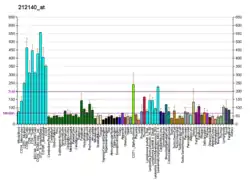PDS5A
Sister chromatid cohesion protein PDS5 homolog A is a protein that in humans is encoded by the PDS5A gene.[5][6][7]
| PDS5A | |||||||||||||||||||||||||||||||||||||||||||||||||||
|---|---|---|---|---|---|---|---|---|---|---|---|---|---|---|---|---|---|---|---|---|---|---|---|---|---|---|---|---|---|---|---|---|---|---|---|---|---|---|---|---|---|---|---|---|---|---|---|---|---|---|---|
%252C_WAPL_(green)_and_IP6_(PDB_5HDT)_(Ouyang_et_al.%252C_2016).png.webp) | |||||||||||||||||||||||||||||||||||||||||||||||||||
| Identifiers | |||||||||||||||||||||||||||||||||||||||||||||||||||
| Aliases | PDS5A, SCC-112, SCC112, PIG54, PDS5 cohesin associated factor A | ||||||||||||||||||||||||||||||||||||||||||||||||||
| External IDs | OMIM: 613200 MGI: 1918771 HomoloGene: 22877 GeneCards: PDS5A | ||||||||||||||||||||||||||||||||||||||||||||||||||
| |||||||||||||||||||||||||||||||||||||||||||||||||||
| |||||||||||||||||||||||||||||||||||||||||||||||||||
| |||||||||||||||||||||||||||||||||||||||||||||||||||
| |||||||||||||||||||||||||||||||||||||||||||||||||||
| |||||||||||||||||||||||||||||||||||||||||||||||||||
| Wikidata | |||||||||||||||||||||||||||||||||||||||||||||||||||
| |||||||||||||||||||||||||||||||||||||||||||||||||||
References
- GRCh38: Ensembl release 89: ENSG00000121892 - Ensembl, May 2017
- GRCm38: Ensembl release 89: ENSMUSG00000029202 - Ensembl, May 2017
- "Human PubMed Reference:". National Center for Biotechnology Information, U.S. National Library of Medicine.
- "Mouse PubMed Reference:". National Center for Biotechnology Information, U.S. National Library of Medicine.
- Sumara I, Vorlaufer E, Gieffers C, Peters BH, Peters JM (Dec 2000). "Characterization of Vertebrate Cohesin Complexes and Their Regulation in Prophase". J Cell Biol. 151 (4): 749–62. doi:10.1083/jcb.151.4.749. PMC 2169443. PMID 11076961.
- Losada A, Yokochi T, Hirano T (May 2005). "Functional contribution of Pds5 to cohesin-mediated cohesion in human cells and Xenopus egg extracts". J Cell Sci. 118 (Pt 10): 2133–41. doi:10.1242/jcs.02355. PMID 15855230.
- "Entrez Gene: SCC-112 SCC-112 protein".
Further reading
- Ishikawa K, Nagase T, Suyama M, et al. (1998). "Prediction of the coding sequences of unidentified human genes. X. The complete sequences of 100 new cDNA clones from brain which can code for large proteins in vitro". DNA Res. 5 (3): 169–76. doi:10.1093/dnares/5.3.169. PMID 9734811.
- Gregson HC, Schmiesing JA, Kim JS, et al. (2002). "A potential role for human cohesin in mitotic spindle aster assembly". J. Biol. Chem. 276 (50): 47575–82. doi:10.1074/jbc.M103364200. PMID 11590136.
- Strausberg RL, Feingold EA, Grouse LH, et al. (2003). "Generation and initial analysis of more than 15,000 full-length human and mouse cDNA sequences". Proc. Natl. Acad. Sci. U.S.A. 99 (26): 16899–903. Bibcode:2002PNAS...9916899M. doi:10.1073/pnas.242603899. PMC 139241. PMID 12477932.
- Ota T, Suzuki Y, Nishikawa T, et al. (2004). "Complete sequencing and characterization of 21,243 full-length human cDNAs". Nat. Genet. 36 (1): 40–5. doi:10.1038/ng1285. PMID 14702039.
- Kumar D, Sakabe I, Patel S, et al. (2004). "SCC-112, a novel cell cycle-regulated molecule, exhibits reduced expression in human renal carcinomas". Gene. 328: 187–96. doi:10.1016/j.gene.2003.12.013. PMID 15019998.
- Rankin S, Ayad NG, Kirschner MW (2005). "Sororin, a substrate of the anaphase-promoting complex, is required for sister chromatid cohesion in vertebrates". Mol. Cell. 18 (2): 185–200. doi:10.1016/j.molcel.2005.03.017. PMID 15837422.
- Ewing RM, Chu P, Elisma F, et al. (2007). "Large-scale mapping of human protein–protein interactions by mass spectrometry". Mol. Syst. Biol. 3 (1): 89. doi:10.1038/msb4100134. PMC 1847948. PMID 17353931.
This article is issued from Wikipedia. The text is licensed under Creative Commons - Attribution - Sharealike. Additional terms may apply for the media files.






